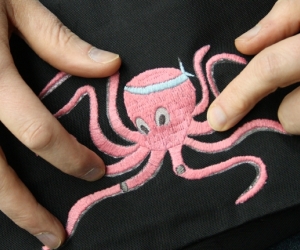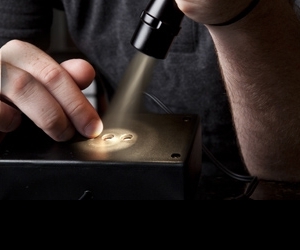Introduction background
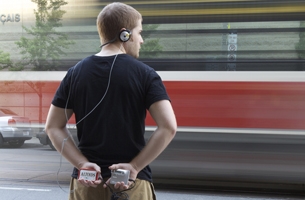
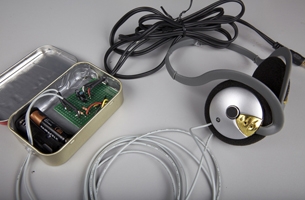
Set Up materials and tools
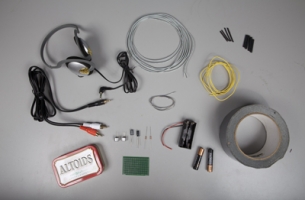
-
a.
1 small piece of circuit board.
-
b.
2 2200-ohm resistors, coded with three red bars.
-
c.
2 1 µF electrolytic capacitors.
-
d.
1 battery holder for 2 AAAs, and the two batteries.
-
e.
1 Altoids or similar tin.
-
f.
2 electret microphone capsules.
-
g.
1 set of headphones to dismantle.
-
h.
1 audio cable, 3.5 mm plug to 2 RCA plugs.
-
i.
Insulated hookup wire, 22 gauge or smaller.
-
j.
Rosin-core electronics solder (consider using lead-free variety).
-
k.
Heat-shrink tubing, sized to fit your mike cable (6 inches).
-
l.
Heat-shrink tubing, sized smaller than 6 inches, for insulating microphone capsule connections.
-
m.
Lightweight card stock, such as for a file folder, cut to the size of the tin (not pictured).
-
n.
Duct tape and masking tape (not pictured).
-
o.
Small-diameter mike cable(6 feet or more), one conductor with shield.
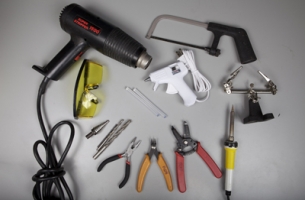
-
p.
Safety glasses or goggles. Please wear them!
-
q.
Small wire cutters.
-
r.
Wire strippers.
-
s.
Needle-nose pliers.
-
t.
Soldering iron, with a small tip, 40 watts or less.
-
u.
1 helping hands tool.
-
v.
Scissors.
-
w.
Hacksaw, to trim circuit board, if necessary.
-
x.
Heat gun or cigarette lighter for shrinking heat-shrink. A hair drier won’t work!
-
y.
Drill, with series of drill bits 1/16 to 1/4 inch. A step bit such as a Unibit is best, although they’re expensive.
-
z.
Glue gun with glue sticks.
Make It project specifications
1 make the power circuit
-
a.
Use a hacksaw to cut the circuit board to 2 in. x 1.5 in.
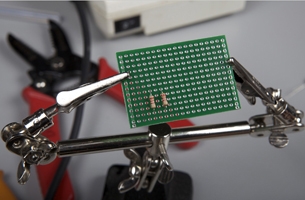
-
b.
Mount the resistors on the circuit board in approximately the locations pictured, leaving the leads closest to you untrimmed.
-
c.
Bend the untrimmed lead of second resistor to the soldered lead of first resistor and solder a connection between the two.
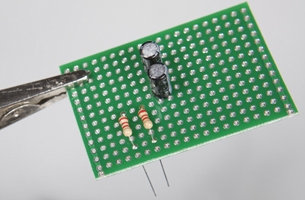
-
d.
Mount the capacitors on the circuit board in approximately the locations pictured.
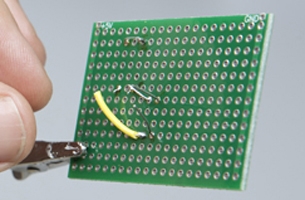
-
e.
Using a length of hookup wire, solder a connection between the positive side (+) of a capacitor and one of the resistors.
-
f.
Repeat step 1e for other resistor and capacitor pair.
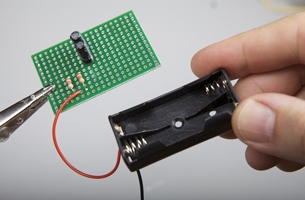
-
g.
Solder the red wire (+) of the battery holder to the junction of the two bias resistors.
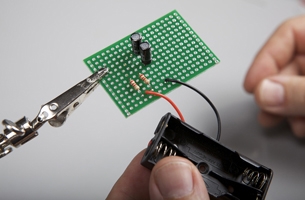
-
h.
Solder the black wire (-) of the battery holder to the circuit board in approximately the location pictured. See figure 1, point E.

-
i.
Solder a length of hookup wire to the circuit board in approximately the location pictured.
-
j.
Solder a connection between the black wire of the battery holder and the hookup wire referred to in the previous step.
2 attach the microphone cables to circuit
-
a.
Cut the six-foot section of mike cable into two equal pieces.
-
b.
Cut a length of the larger-diameter heat-shrink tubing and slip it over one end of one of the mike cables.
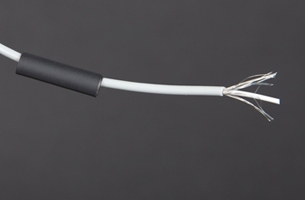
-
c.
Remove approximately 1inch of cable jacket with wire strippers
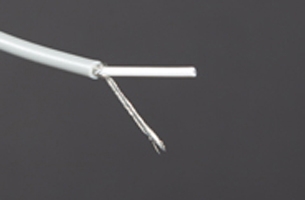
-
d.
Twist the shield strands together.
-
e.
Strip a small piece of insulation off of the centre conductor.
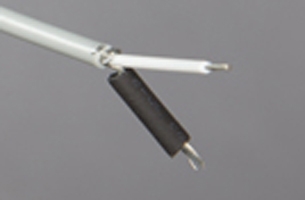
-
f.
Cut a small piece of heat-shrink tubing to cover all but 1/4 inch of the shield, and shrink in place with the heat gun.
-
g.
Slide larger heat-shrink tubing down over the edge of the cable jacket. It should cover the cut edge, but leave the shield and centre conductor long enough to connect to the circuit board.
-
h.
Shrink in place.
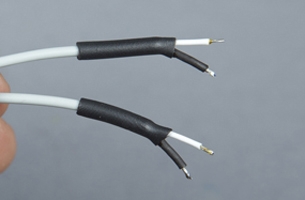
-
i.
Repeat these steps for the second piece of mike cable.
-
j.
Solder one of the mike cables (both twisted shield and the centre conductor) to the circuit board, taking care not to short the shield to the centre conductor.
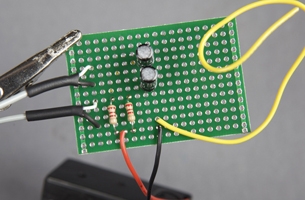
-
k.
Repeat with second mike cable.
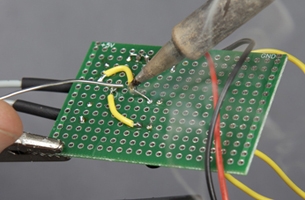
-
l.
Using a length of hookup wire, solder a connection between the centre conductor of one mike cable to the junction of one bias resistor and its paired capacitor.
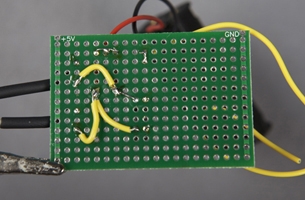
-
m.
Solder a connection between the centre conductor of the second mike cable to the junction of the other bias resistor and its paired capacitor.
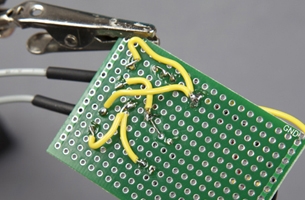
-
n.
Using hookup wire, connect the shields of both mike cables to the common ground point made in step 1c.
3 attach the audio output cables to circuit
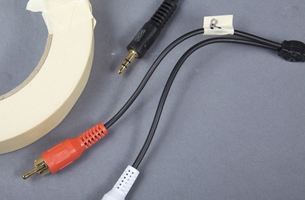
-
a.
With a piece of masking tape, label the audio cable attached to the red plug.
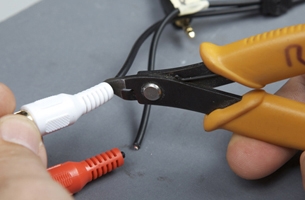
-
b.
Using wire cutters, remove the RCA plugs.
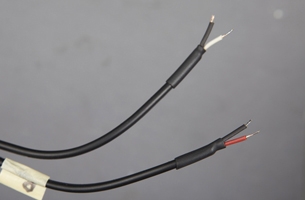
-
c.
Strip and prepare the ends of the audio cables as in 2b through 2i.
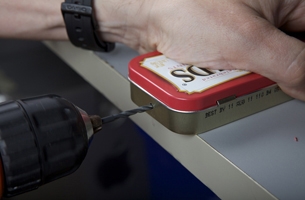
-
d.
Using a power drill, carefully drill a hole into each end of the tin. Start with the smallest bit you have, and gradually work the hole up to the proper size, using progressively larger bits. Make it only as big as it needs to be for the cables. The larger it is, the more ragged it will get. If you have a step bit such as a Unibit, use it here.
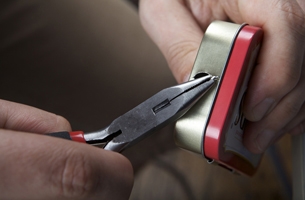
-
e.
Deburr the edges of the drilled hole with needle-nose pliers. Or, if you have a small round file, use it to smooth the edges of the hole.
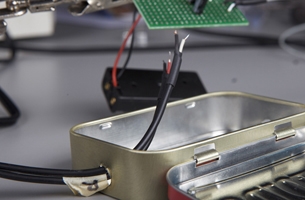
-
f.
Route the free ends of the audio cables through one hole in the tin.

-
g.
Solder the centre conductor of the red-labelled cable and its twisted shield to the circuit board, taking care not to short the shield to the centre conductor.
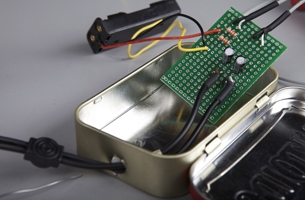
-
h.
Repeat with second audio cable.

-
i.
Using a piece of hookup wire, solder a connection between the centre conductor of the red‑labelled audio cable to the negative side (-) of one of the capacitors.
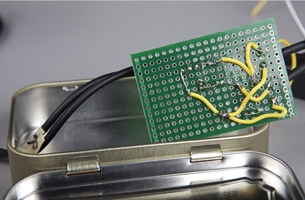
-
j.
Using a piece of hookup wire, solder a connection between the centre conductor of the second audio cable to the to the negative side (-) of the other capacitor.
4 fit circuit into tin
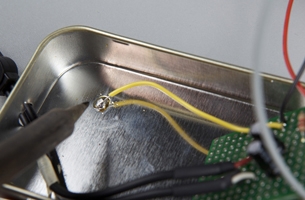
-
a.
Solder the free end of the ground lead to the bottom of the tin.
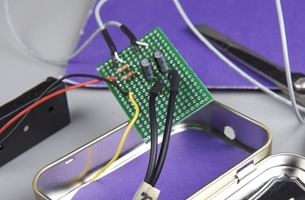
-
b.
Cut a piece of cardboard to fit the bottom of the tin and place it into the tin, making sure the ground lead comes out and over the cardboard.
-
c.
Cover the cardboard and all inside surfaces of the tin with duct tape, taping the cardboard to the sides and bottom of the tin.
-
d.
Route the free ends of the mike cables from inside the tin through the remaining open hole in the tin.
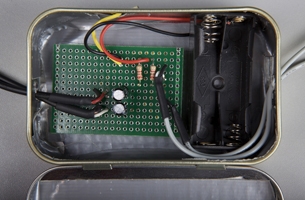
-
e.
Place the circuit board into one end of the tin and the battery holder beside it.
5 connect the microphone capsules
-
a.
Prepare the free end of one mike cable as in steps 2b through 2e.
-
b.
Cut a small piece of heat-shrink tubing to cover all but a 1/2 inch of the shield, and shrink in place with the heat gun.
-
c.
Slide larger heat-shrink tubing down over the edge of the cable jacket. It should cover the cut edge but leave the shield and centre conductor long enough to connect the microphone capsule terminals.
-
d.
Shrink in place.
-
e.
Repeat steps 5a through 5d for the free end of the second mike cable.
-
f.
Cut 2 small pieces of heat-shrink tubing the length of the microphone capsule terminals and slide over both the shield and conductor of the mike cable.
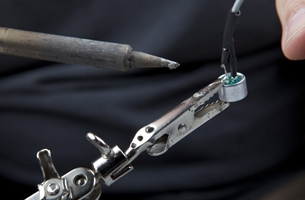
-
g.
Solder the centre conductor of one of the mike cables to the positive terminal (+) of the microphone capsule.
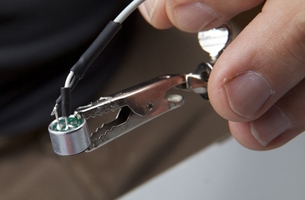
-
h.
Solder the mike cable shield to the negative terminal (-) of the microphone capsule.
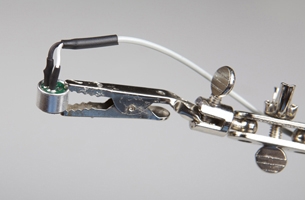
-
i.
Slide small heat-shrink tubing down over the soldered microphone capsule terminals and shrink in place.
-
j.
Repeat steps 5a-i with other microphone capsule.
6 test your equipment
-
a.
Connect the audio output to your recorder microphone input.
-
b.
Connect the batteries.
-
c.
Put recorder into record mode and make distinct sounds into the left and right capsules.
-
d.
Monitor recording to ensure that you are getting signal from both capsules, that the left capsule is the left signal, and vice versa.
7 finishing the project
-
a.
Hot glue the circuit board into the tin.
-
b.
Hot glue the cables into the centre of the holes in the tin, ensuring that cables are centred in the hole and are not catching any rough edges.
8 fabricate the microphone head mount
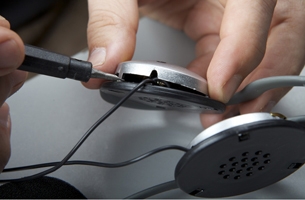
-
a.
With a small screwdriver, remove the earpieces from the headset.
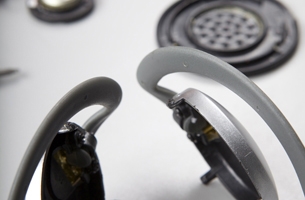
-
b.
Remove the small speakers from the earpieces and discard the speakers and cable.
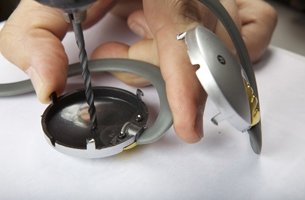
-
c.
Drill a hole that’s the diameter of the microphone capsule into the centre of the headphone earpiece. Take extra care when drilling not to crack the plastic. Use a step bit if you have one. You may want to drill a small hole and enlarge it with a small round file.
-
d.
Fit microphone capsule through the earpiece holes so they are facing outward. Make sure that the left microphone capsule is in the left earpiece and vice versa.
-
e.
Secure the microphone capsule with hot glue into the earpieces, ensuring that the fronts of the capsules don’t get covered with glue.
-
f.
Route the mike cables in the manner of the original headphone cables.
-
g.
Secure mike cables with hot glue for strain relief.
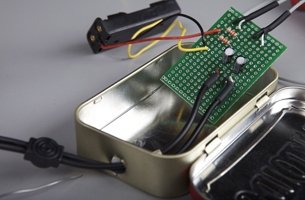
-
h.
Cover the microphone capsules’ wire connections with hot glue in order to secure wiring.
-
i.
Reinstall the earpieces on the headset, making sure to route the cables in the manner of the original headphone cables.
Help! troubleshooting

Use It binaural microphone technique
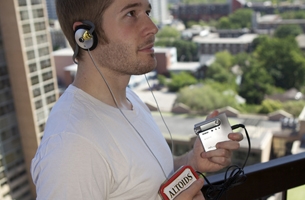
Use It record and experiment
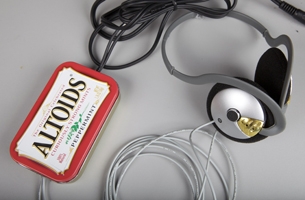
Use It listen
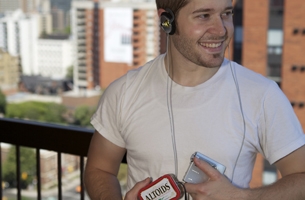
Reference binaural microphone circuit schematic
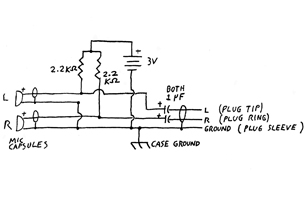
Reference glossary

